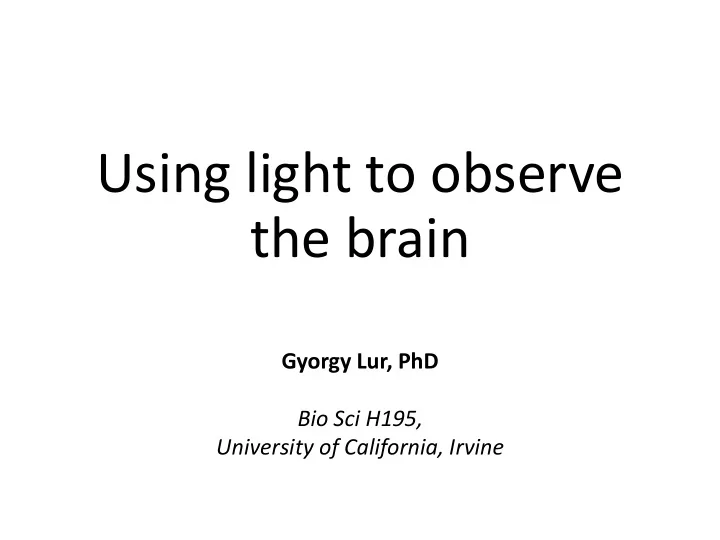

Using light to observe the brain Gyorgy Lur, PhD Bio Sci H195, University of California, Irvine
Course overview: 4/23 Using light to observe the brain 4/28 Chasing causality – what can we learn from controlling neuronal activity? 4/30 Manipulating neurons with light 5/5 New approaches to simultaneously drive and measure neuronal activity 5/7 Journal Club and student presentations 5/12 Lab Tour
Journal club papers: 1) Flow of Cortical Activity Underlying a Tactile Decision in Mice. Guo 2013 https://www.sciencedirect.com/science/article/pii/S0896627313009240?via %3Dihub 2) Acute off-target effects of neural circuit manipulations. Otchy 2015 https://www.nature.com/articles/nature16442 3) Sensation, movement and learning in the absence of barrel cortex. Hong 2018 https://www.nature.com/articles/s41586-018-0527-y Presentations up to 10 minutes (10 slides maximum). Capture the primary message of the paper, do not present all figures! 30-minute discussion panel after presentations.
How to learn about the brain? Observe behavior e.g.: social behaviors, vocalizations, complex questioners (human) Electrical recordings surface electrodes (EEG, ECoG), tetrodes, silicone probes, single cell techniques Imaging techniques anatomy (CT), functional MRI, intrinsic signal (blood flow), fluorescent imaging
Fluorescent imaging techniques 1) Morphology / Structural imaging 2) Voltage imaging 3) Calcium imaging
Imaging neuron structure Goal: quantify dendritic morphology or spine number Approach: - Ex vivo Wide field fluorescence, confocal, correlation EM - In vivo 2-photon microscopy Example questions 1) Does learning increase spine number in the hippocampus? 2) How does stress affect dendritic complexity?
Comparing microscope types Wide field imaging vs. confocal microscopy vs. multiphoton short wavelength scatters more long wavelength goes deeper out of focus fluorescence optical sectioning
What do we need to image cell structure? Fluorescent dye inside a cell 1) Express fluorescent proteins 1) Sparse labeling 2) Cell type specific (Cre-loxP system) 2) Fill cell with nonprotein fluorescent dye 1) E.g. though patch pipette
Example – stress leads to dendritic spine loss Correlated memory defects and hippocampal dendritic spine loss after acute stress involve corticotropin-releasing hormone signaling Y. Chen et al. PNAS 2010
Imaging voltage Goal is to measure neuronal activity - ex vivo Wide field fluorescence w/ fast cameras Spinning disc confocal - In vivo Wide field fluorescence w/ fast cameras 2-photon microscopy – less common Examples 1) What brain area is active during this behavior? 2) How do action potentials propagate in the axon?
How to visualize voltage? Fill neurons with voltage sensors 1) non-protein voltage indicators 2) Genetically expressed voltage sensors
Example: action potential propagation The spatio-temporal characteristics of action potential initiation in layer 5 pyramidal neurons: a voltage imaging study MA Popovic et al. J Physiol 2011
Example: voltage imaging during behavior Voltage-sensitive dye imaging of mouse neocortex during a whisker detection task. Kyrakatos et al. Neurophotonics, 2017
Imaging calcium Goal is to measure neuronal activity - ex vivo Wide field fluorescence spinning disc confocal 2-photon microscopy - In vivo 2-photon microscopy Wide field Examples 1) Do action potentials propagate into dendritic spines? 2) How do drugs effect excitatory transmission? 3) Where do inputs arrive on a dendrite? 4) What neurons are active during behavior?
But why calcium? Synaptic activity (NMDA-receptors) Action potential firing (VGCCs)
How to visualize calcium? Fill neurons with voltage sensors 1) non-protein calcium indicators 2) Genetically expressed calcium sensors Lee 2015. Scientific reports
Wide field Ca2+ imaging in the brain 6:50 – 8:15 9:30 – 10:30
Example: modulation of action potential backpropagation Glutamate Receptor Modulation Is Restricted to Synaptic Microdomains. Lur et al. Cell Reports, 2015
Example: visual properties of excitatory neurons Projection-Specific Visual Feature Encoding by Layer 5 Cortical Subnetworks. Lur et al. Cell Reports, 2015
Recommend
More recommend